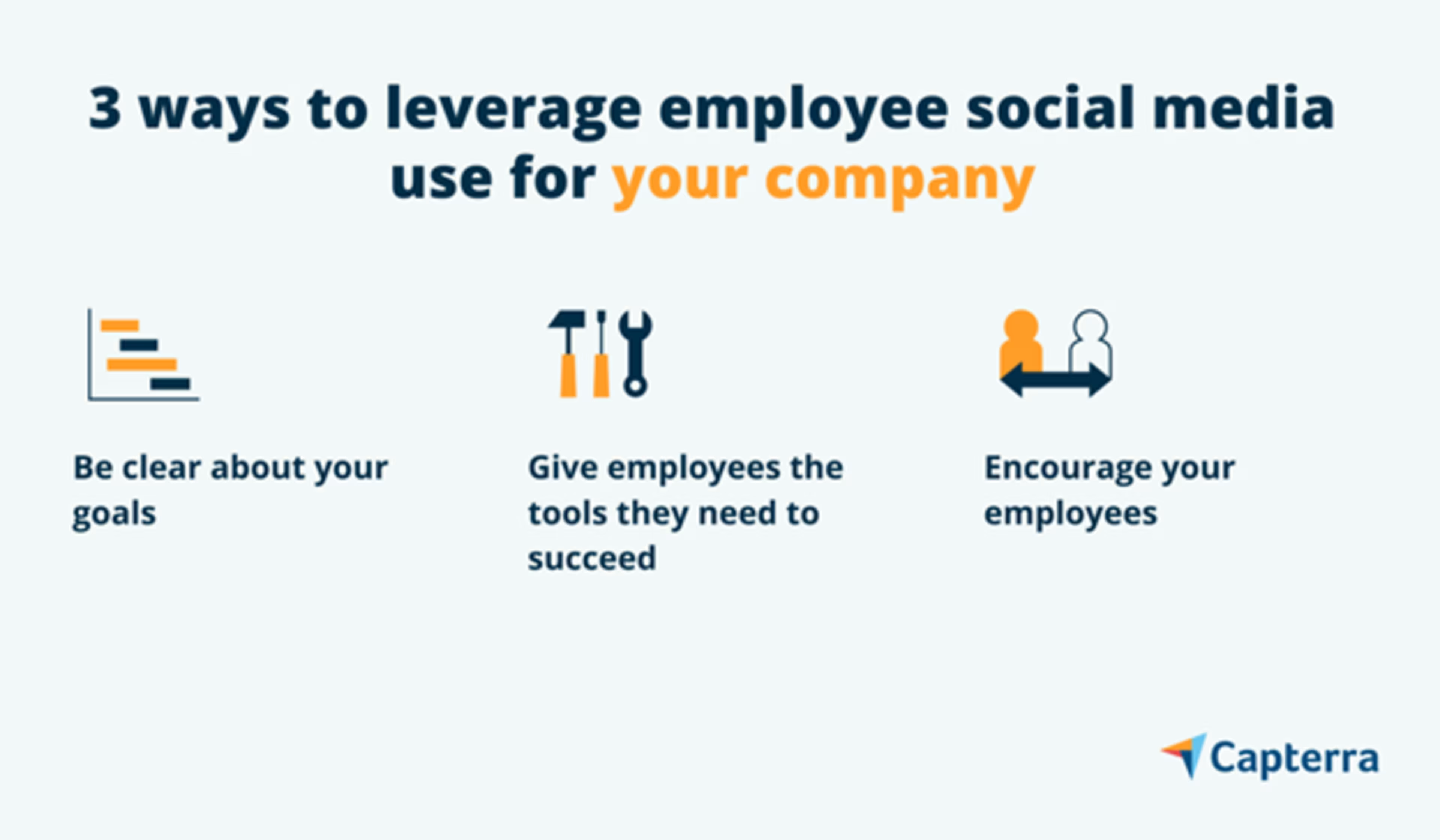An effective employee social advocacy program can expand your organization's marketing reach.
Marketers are used to other people not knowing what we do—it comes with the territory.
While that might have worked in the pre-internet days or even in the early years of this century, it doesn’t work in the age of social media for two reasons:
First, nearly everyone uses some kind of social media daily. In fact, there’s a solid chance that you came to this post from social media.
Second, B2B buyers are people, too, meaning they’re turning to their social networks in order to do their jobs. Most marketing teams are already using social media as a powerful channel for generating demand. But there’s so much more to be gained if you scale your social media reach by leveraging employees outside of your marketing team, as well. If you aren’t encouraging and enabling your employees to extend your reach to their own networks via an employee social advocacy program, you could be leaving valuable opportunities on the table.
Narrow your search for social media marketing agencies with our list of agencies in the following areas:
3 ways to leverage employee social media use for your company
Before we dive in, it's worth noting that while the following three ideas may be simple, they’re not easy. Any sort of change takes persistent effort, training, communication, and enablement.
However, once it catches on, you’ll be shocked at the results you can achieve.

1. Be clear about your goals
You can’t get the results you want if you’re not clear on what it is you’re trying to accomplish. It requires upfront effort but can reduce friction down the line.
First of all, make sure that your organization has a clear social media policy in place. I’m not talking about a formal legal-sounding policy referring people to “consult HR with any additional questions,” but something human and honest that encourages employees to speak openly.
How your team members conduct themselves on social media is no different than if they were in the office or at a conference. Though you don’t have control over what your employees do and don’t post, it’s important to make it clear that their behavior online can have the same implications as their behavior offline.
Don’t just simply tell your whole organization to “promote our next webinar on LinkedIn” and call it a day. What you’ll end up with is team members rotely reposting just to check that box off their list.
To maximize employee engagement and results, start with clear goals in mind. Are you looking to drive more event registrations? Traffic to your website? Something else? Understand what success looks like first, then go to your organization with the exact contributions you need from them to succeed. You'll get more employees involved when you're specific and provide clear guidelines.
2. Give them the tools they need succeed
Not everyone joins an organization with the same understanding about social media that marketers might have. They might not understand the powerful effect it can have for promoting the company’s mission and image.
Another thing that’s important to keep in mind: Not everyone is at the same level of comfort on social media. That's OK; you’re not looking to get 100% buy-in.
While you can't (and shouldn't) force anyone to take part in social media promotions, evangelizing, and the like, you can help empower those who are on the fence to participate by giving them the social media tools they need and showing them the payoff.
This could include bringing in external consultants/educators or giving your teams templates and frameworks to work from.
Want to learn more before hiring a social media marketing agency? Capterra’s list of the top agencies and their features will help you narrow your search. Read more in Capterra’s social media marketing agency hiring guide.
As you roll these tools out across your organization, it’s important that you deliberately seek to get better by utilizing:
Internal communication: Take advantage of every single communication and collaboration tool you’ve got at your disposal. Your company's intranet, communication channels, internal newsletters, whatever format your employees engage with best.
Learning: Always seek feedback from across your organization. You can’t improve if you don’t think there’s a problem or know about an issue.
Reflecting: Not all feedback is created equally. Be sure to consider feedback in terms of where it’s coming from, how many people are reiterating the same point, etc.
Like an always-on marketing campaign, you should never stop enabling your employees to utilize social media to advance their career, share big wins, and make connections.
3. Encourage your employees
Anyone who thinks that you can just tell a large group of people something one time and expect consistent, perfect follow-through is either extremely optimistic or has never worked with others before.
If you’re looking to get your whole organization involved in your social media marketing efforts, you have to not only tell them what you want but encourage the behavior as well. Ways of doing this include modeling what you want, rewarding efforts, and public recognition.
Explore top employee recognition tools at a glance with Capterra Shortlist
Making social media a whole-company endeavor goes a lot further with leadership buy-in. Having your senior leadership team be active on social media and commenting on posts shows the seriousness of your initiative.
Internal competition is also an effective way to boost engagement. By gamifying the social media experience, you can not only hit your goals but make the process fun.
For example, let's say you’re trying to drive registration for an upcoming event. Give each employee a unique link for registering attendees, an idea of what to say, then set them loose.
Using your marketing attribution software or web analytics tool, you can easily track activity and reward frontrunners. You’ll be amazed at how far some people will go, even just for bragging rights—or, you can reward employees in the form of time off, a gift card, recognition, or anything else that’ll get your employees buzzing.
Once again, you’re never going to get 100% adoption but it’s still vital that you visibly thank those who are helping put in the extra effort.
Incorporate employee social advocacy into your promotional plans
This point goes for any sort of campaign planning, but whenever you’re adding a promotional channel as a part of your strategy, you need to incorporate it into your plans and articulate exactly what that means.
Don’t just list “social media promotion” as a line item in your project management software and call it a day. Break it down into smaller pieces and tasks so you understand exactly who is doing what, when, and why.
That means knowing what your marketing team is going to do, what actions sales enablement will take, and how the larger organization might get involved.
Remember, while you might think you can just figure it out as you go along, you probably can’t and won’t. It’s worth it to invest that time upfront in order to avoid any last-minute scrambling.
Recruit for employee social advocacy
Another way you can incorporate employee social advocacy into your plans is by understanding incoming and current employees' skill sets.
Does a new employee have a connection with an existing brand that complements your efforts? Is there a current team member who already has a respected following? These are all important aspects to consider when launching or improving an employee advocacy program.
Whether you’re in cybersecurity, healthcare, or insurance, there are trustworthy voices that people turn to for advice, best practices, or trends. You can do the exact same thing. Justtry to find that person (or those people), internally or externally, who can be that voice and expand your reach.
It’s great if they are a high-level executive but even better if it is someone who has been in the trenches or still is working on the front lines in your industry. Their advice will resonate in a huge way.
All hands on deck for social
Scott Cook, co-founder of Intuit, has said that “A brand is no longer what we tell the consumer it is—it is what consumers tell each other it is.” Employee advocacy needs to be a whole team effort and involve everyone, not just a social media marketing manager.
To do this, you’re going to want to:
Set goals ahead of time and build them into your plans
Identify the employees already in your organization who can help
Give your employees the training and tools they need
Continue to support and encourage
Social media marketing isn’t a one-and-done sort of thing. Every network changes, your team will change, your brand will evolve, and your efforts need to change with them.
The right tools can make your employee social advocacy program even more effective. Explore top tools in Capterra's directory, and filter by desired features, pricing, and more.

